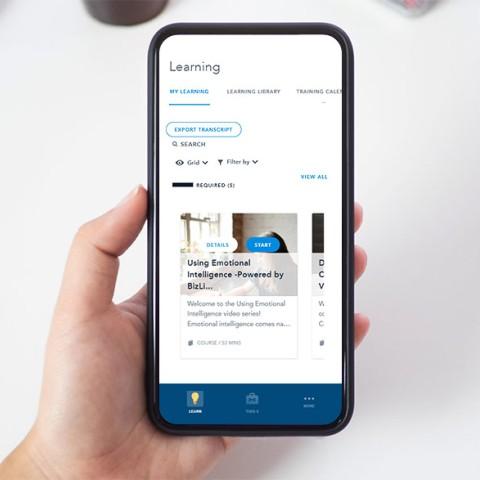- Human Resources
- Article
- 6 min. Read
- Last Updated: 04/29/2025
Employee Training and Development: Why You Can’t Go Without It

Table of Contents
Talent management represents the full scope of HR processes for attracting, onboarding, developing, motivating, and retaining high-performing employees. It is a critical part of every business strategy and can play a crucial part in a company's bottom line.
Plus, having a robust training program can help you stand out as an employer to attract top talent, especially in today's challenging labor market.
Types of Employee Training Programs
Training is an essential part of the talent management cycle; it can help develop the skills and expertise needed within your business and is critical in developing your organization's future leaders. And, overall, building effective training programs for your employees can significantly affect productivity and employee retention. Not only that, but it is often much more cost-effective to promote and retain employees within your company than it is to continually hire talent from outside your organization.
There's no one-size-fits-all approach to employee training. Ultimately, it comes down to your company goals, employee needs, and available resources. That said, let's look at some successful employee training methods and topics you may wish to consider for your training programs.
Training and Development Opportunities
Skill-building and career development are top priorities for businesses of all sizes today, and 64% of Millennial and Gen Z workers say they prioritize career growth and development when it comes to their jobs.1
What Is Employee Training?
Employee training is often divided into 2 types: hard skills and soft skills. Both can be equally valuable for employee development.
- Hard skills training. "Hard skills" are the technical skills your employees need to succeed in their current jobs and beyond. Computer and software skills, data analysis, and project management all fall under this category.
- Soft skills training. "Soft skills" are non-technical skills associated with how employees interact with colleagues, solve problems, and manage their work. These skills can be crucial when it comes to developing your company's future leaders. Effective communication, interpersonal skills, presentation skills, and time management are all examples of soft skills that can be continually improved.
Procedural Training
Providing your team with training that focuses on specific processes within your company can help ensure that documents stay up-to-date and that each job is carried out with consistency. This can help lay a solid foundation for employee productivity. Other procedural trainings, such as workplace safety, employee conduct, and legal training — such as harassment prevention or anti-discrimination training — can help you mitigate and reduce risk within your organization.
What Is Employee Development?
Employee development can refer to a broader effort to help employees grow and flourish in their roles and in their overall professional trajectory. Trainings may be components of a strategic employee growth plan or career path, but leadership development, for example, takes time, experience, and intention to cultivate.
Leadership development
Managing people demands its own unique skill set, so it's particularly essential to provide new managers with the development opportunities they need to thrive in their role. Emotional intelligence, negotiating, and conflict management are all good examples of the skills necessary to succeed in a managerial role.
The benefit of having a leadership development program is twofold: When managers are better equipped to do their jobs, the employee experience improves, too, which can improve employee engagement and retention.
Training Methods
Now that we understand the basics of employee training and development, consider the following models for training:
- E-learning. Implementing an e-learning program can be a cost-efficient way to give consistent training opportunities to your team. Investing in an online learning management system (LMS) can make it easy to offer a wide range of valuable learning opportunities for your employees and can help you keep track of their progress. Many e-learning programs offer pre-existing content on popular training topics, as well as the ability to create your own content to fit your company's needs.
- In-house training. Consider having employees coach their colleagues on industry best practices or consider instituting a cross-training program that can help employees expand their institutional knowledge across an array of business areas.
- External training. Tuition reimbursement programs are a great development option for organizations that want to develop employees and grow future leaders. With proper controls, the return on investment can far outweigh the costs.
How To Build an Effective Employee Training Program
Create a robust employee training and development program by following these 4 best practices:
- Perform a skills gap analysis. Determine the skill sets missing from your workforce and identify what specific training is needed to help fill those gaps.
- Define goals and metrics for your program. Based on insights gathered from your skills gap analysis, determine what your goals are for your training and development program and what metrics you'll use to define the program's success. To get started, you may consider your organizational goals and how your training and development program can help you reach them.
- Gather employee feedback. In some cases, your employees may know what training they need to feel more confident in their jobs. In this case, they can provide you with insights into the types of programs and opportunities they'd like your organization to offer.
- Choose a medium for training sessions that supports your employees. Online, on-demand professional training modules can provide employees with the flexibility they need to complete coursework at their convenience. Likewise, some professional development subject matter may be better retained when offered in a personalized classroom or lunch-and-learn-style setting. In those cases, be mindful of:
- Where employees are located;
- Whether employees need to be compensated for this time;
- Whether specific roles allow the ability to attend a course during the workday; and
- How to handle registration, development of course material, and gauging the effectiveness of the program to decide if it's worth repeating.
How Employee Training and Development Impacts Your Bottom Line
Employee training and development benefits employees and is a crucial factor in growing your organization's bottom line. Let's examine the benefits of investing in a robust employee training and development program.
Increased Productivity
Procedural training and training on new technologies can help increase efficiencies in processes — especially in today's hybrid work environment — which can lead to increased productivity that results in financial gain.
Lower Turnover
Employee training and development programs can help increase job satisfaction, motivation, and engagement, which may result in lower employee turnover. This directly affects your bottom line: To replace an employee who earns $50,000 annually could cost $16,500 or more, assuming wage growth in 2025.2 Not only that, but losing top talent can put your company at a competitive disadvantage and, if it happens often enough, can hurt your company's ability to attract top talent to join your team.
Reduced Risk
Employee training offers the opportunity to arm your staff and, ultimately, your business with the tools and information needed to reduce the risk of injury or potential legal disputes — both of which can come at a high cost for your company, not just monetarily. These issues also have the potential to hurt your business's reputation, which can make it harder to attract talent and customers.
Additional Benefits of Employee Training and Development
Investing strategically in employee training and development can help you:
- Strengthen skill sets. Reskilling and upskilling training can help employees who need to improve in certain areas and, conversely, enhance current knowledge with up-to-date information. In turn, the organization enjoys the benefits of being at the forefront of its field.
- Nurture a healthier corporate culture. Investing in training sends a clear message: you care about staff and believe in your employees. This can foster a sense of belonging in employees, who may work harder and be more committed to their teams.
- Improve retention. Benefits have long been proven to help companies boost employee morale and increase retention.
- Enhance employee advancement. An organization is no different. Workplace training allows your business to nurture leadership potential from within and can help ensure future transitions are smooth, effective, and efficient.
- Increase engagement and performance. Strengthening an employee's skill set is one way to bolster their confidence and help them take greater ownership of their role. This can translate to increased job satisfaction, productivity, and engagement.
- Ensure consistency. If you want the same information given to all staff members, a structured training program can provide a knowledge base on processes and procedures that get everyone on the same page.
1 Navigating the New Workforce, Paychex 2024
2 2025 Retention Report, Work Institute
Improving Employee Training Effectiveness With Paychex
Looking to define — or redefine — your employee training and development strategy?
Explore how the Paychex online learning management system (LMS) can provide your employees with an extensive catalog of online courses, plus let you add your custom courses, videos, quizzes, and reminders.


Tags








